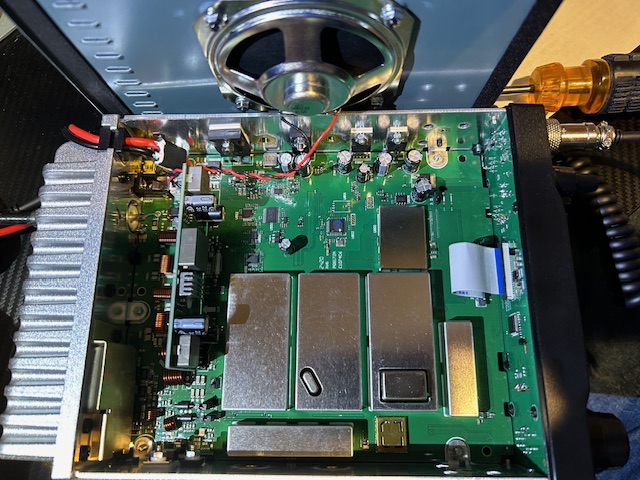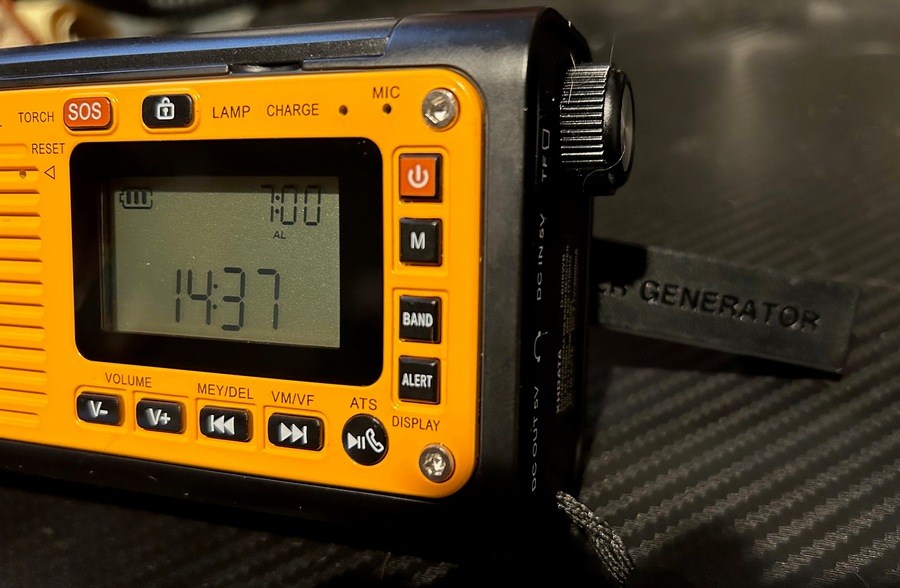By Robert Gulley
I admit to being hesitant to review this radio when XHDATA contacted me, as our own armchair portable radio guru, Jock, had written an excellent review of the radio back in June of this year, and because the radio has been out for some time (6 or 7 years, I believe). After a time, I decided my take on the radio, like any other, would be just another facet in considering its place in the radio world at large, or possibly on your radio shelf, and hence this review.
Lightweight and a Sturdy Antenna
As Jock mentioned in relation to other lightweight DX machines, this radio is indeed light, yet sturdy, and very easily portable. Unlike many small radios, care has been taken to make the antenna solid and tall. This means it can pull in a lot of signals safely (unless, like me, you are comparing it side-by-side with three other radios and find yourself having antenna sword fights as you move radios around, but I digress. Fortunately, nothing bad happened to any of the radios!). When sitting on a table, the built-in stand is stable, and allows pressing buttons solidly with one hand – the radio does not slide around or threaten to be knocked over in the process. That might seem like a minor thing, but many stands are less than reliable in this regard.
Operating the Radio
While I would prefer a slightly larger offset to the buttons from the surface of the radio, this did not cause much of an issue whether hand-held or on its stand. There were a few times when I thought I had pressed a button sufficiently but no response, but a second, harder press worked, so I just needed to take that into account when tuning in frequencies using the keypad, or when changing modes, etc.
The radio has a number of functions, clearly labeled, including operations performed when the radio is off, labeled in orange. Other orange labels indicate secondary or sub functions when the radio is on, such as the “Meter” function which, when in SW mode, cycles through the shortwave bands.
A small but useful feature I really appreciate related to this is the meter identification displayed along with the frequency as you cycle through the shortwave bands. For some reason I have a hard time remembering which set of frequencies is represented by which SW meter band. Perhaps with this radio I can finally get them firmly entrenched into my old brain!
Another operating feature that I found very useful is the Fine Tuning dial on the side of the radio. This works as one would expect in Shortwave and SSB mode, allowing for slight adjustments to bring in a voice or CW signal in the amateur bands, but also allows one to off-tune from the standard receive frequency when a signal is being interfered with or picking up static etc.
This is nothing particularly new, but what is impressive to me is that it works for MW signals as well. Being able to go from 700 kHz to 701 or 702 kHz, for example, sometimes allows for a more intelligible signal, particularly at night when there can be multiple stations coming in on the same frequency.
On more than one occasion this was useful, especially since this means one does not have to change the tuning rate to make an adjustment. Your main tuning stays at the 9 or 10k you have set, and when you move the main tuning dial, it jumps to the next proper frequency. In this example, 701kHz becomes 800kHz with the next turn of the main tuning dial or up arrow,
Listening
The audio is good for its size due to the large speaker, and the multitude of filter options in the radio for every mode (except FM) allow you to tailor the audio to what you prefer, or what will allow you to mostly, or totally, eliminate interference from strong nearby stations. For those who like to listen to amateur radio bands, the filter capability is even more useful, particularly since it goes down to 500 Hz, great for listening to Morse code!
The number of filters is amazing given the price point of this radio, and it begs the question, if XHDATA can do this, why can’t other companies do this too? This is a big selling point for the radio in my book.
As I mentioned earlier, I compared three other radios to the D-808, a Sony 7600GR, a Sangean 909X2, and a C.Crane Skywave. The results were both predictable and surprising. Predictable in that the Sangean with the larger speaker had better audio, the Sony with SSB sync that actually works (unlike many models that try and fail!) was a bit clearer most of the time on SSB, and the Skywave was weaker in strength due partly, at least, to the smaller antenna, and lesser audio due to the smaller speaker.
What was unpredictable was when the D-808 pulled in stations better than the Sangean or Sony – not often, but some times. Similarly, the D-808 would sometimes hear two MW broadcast stations when the other three would only hear one. All three were used at times with a Tecsun AM loop antenna to boost MW signals, as well as with their bare ferrite antennas. Most of the time the MW signals were pretty even, but sometimes the D-808 won out.
While I have yet to own the perfect radio, and I have owned a lot of radios, this radio does what it promises, and does it well. As I note below, there are pros and cons and quirks to every radio, and what may be a quirk or a con to me may not be to others.
PROs, CONs, and Quirks
PROs
- Excellent sensitivity on FM (good telescopic antenna) and AM (internal ferrite antenna excellent given the size of the radio)
- Includes the AIR band, SSB with USB and LSB, and LW
- 6 filters for SW, 7 for MW/LW, and 6 for Air (WOW!)
- Fine Tuning Dial works in all modes to help reception
- Tuning Dial can be adjusted for Fast or Slow tuning steps, and can be set to STOP to lock in a station so that if the dial is accidently nudged, the station will not get changed.
- Direct Keypad entry of frequencies
- Feature rich for an (almost) ultralight radio
- External antenna jack
- Long-lasting battery
- Reset Button to go back to square one if needed
CONs
- While I do not mind soft muting, this radio does make a “chuffing” sound in certain modes when tuning manually (but not when finding stations with ATS). That’s not a deal-breaker for me, but it will be to some, I know. This is likely due to the AGC “attacking” the audio as it returns from the soft muting.
- Minor Nit: While the battery life is good with the rechargeable battery included, I always prefer AA-sized batteries for their almost universal availability.
- Memory access is limited, not by the number of memories, but by an easy way to tune through them. Memory Pages should link seamlessly for scanning purposes, but this is not an uncommon CON with many other radios.
Quirks
- Setting the Sleep Timer to “On” actually turns it off. Really.
- Sometimes if the Clock adjustment is set to Auto, an FM radio station that broadcasts RDS time and date info might reset the time to something different, such as when hearing a station from a different time zone. I prefer to set the clock manually to my local time (or more likely, to UTC time) just to keep it consistent, and that option is available for this radio.
- I have noticed when another radio is near, when changing the frequency manually, in addition to the chuffing noise of the D-808, the other radio will make a popping sound with each change. This is not likely to be an issue in normal operation, but if comparing two radios, or listening to two different radios at the same time, you will likely hear it.
- The alarm time set shows on the main display when the radio is turned off, regardless of whether the alarm is set to go off or not. This was very confusing to me at first, as I expected the display to go off when the alarm was not set to go off.
Wrap-up
This is a neat little radio that, as they say, punches above its weight class. It can fit in a jacket pocket easily, it’s lightweight, it has features which not many other portables have, or have as fully, and the audio is quite good for its size.
This is indeed an armchair receiver, but with the addition of a MW loop antenna, or a longwire plugged in for shortwave/amateur or LW/MW bands, there are many more opportunities for bagging distant stations.
There are enough features to make it quite usable for travelling, but not so many bells and whistles that operation becomes cumbersome. And with keypad entry for when you want immediate gratification, there’s no long minutes or hours of tuning manually to get to the frequencies you want.
I believe the radio comes in at a good price point, ticks most boxes a user would want for a radio in this class, and has a track record of good reliability after a number of years on the market.
________________________________________________________________________________________
As with the D-220 promotion specifically for SWLing readers, below are links and codes to save a bit of green (or is that plastic now?!).
Discount Information (from XHDATA)
Regarding the pricing details for the XHDATA D808 radio, the original price of the D808 is $108. Currently, it’s part of Amazon’s Black Friday promotion, offering a 20% discount.
Additionally, we’d like to provide you with a stackable 5% discount code, making the final price approximately $5 lower than the special Black Friday price.
(ed. Note: includes free delivery in the states when purchased through Amazon U.S.)
Here are the exclusive discount codes:
- Gray D808: 05dealforSWL
- Black D808: 06dealforSWL
- Effective time: From 2024-11-27 08:00 PST To 2024-12-3 23:59 PST (Pacific Standard Time)
Product links:
- Gray D808: https://www.amazon.com/dp/B0BL266J33
- Black D808: https://www.amazon.com/dp/B0DCFZYMHY
I tested the above links and codes, and as of this writing both were working properly at Amazon U.S.
73, Robert K4PKM















